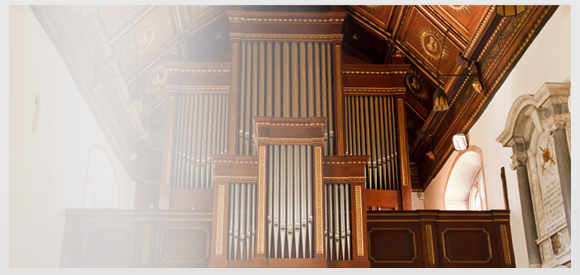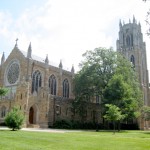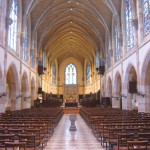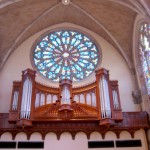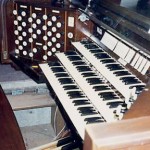University of the South —All Saints’ Chapel
The original University chapel was named Saint Augustine’s Chapel, for Saint Augustine’s School in Canterbury, England. The cornerstone was laid on August 2, 1867. The frame building was completed in time for the official opening of the University on September 18, 1868. Saint Augustine’s was enlarged nine times while it served as the spiritual center of the University for 42 years, 1868-1910. A stone just south of the present chapel marks the site of the altar of the first Saint Augustine’s Chapel.
Groundbreaking for All Saints’ Chapel was held in 1904 in anticipation of the 50th anniversary celebration of the University. All Saints’ was to replace the old wood Saint Augustine’s Chapel on the south lawn. The 1904 designs were drawn by the noted New York architect, Ralph Adams Cram. Construction was actually begun with the laying of the cornerstone in 1905, but the work was halted because of the failure of the Bank of Winchester during the great financial panic of 1907. In 1910 a temporary wooden floor and ceiling made the chapel available for use.
The final stage of construction was begun in 1957 in preparation for the celebration of the 100th anniversary of the University. The plans for the completed chapel were executed by Dr. Edward McCrady, then vice-chancellor, from exterior plans that he drew in 1937. Dr. McCrady’s ideas for the design of the University chapel came from many sources. The tower is primarily based upon that of Saint Mary the Virgin, the University Church at Oxford University, England. The vaulted ceilings are designed principally from the models of the medieval cathedrals of Chartres and Amiens in France. The rose window is based upon that of the south transept of Notre Dame de Paris in France. Although All Saints’ Chapel was completed in July 1959, it was not consecrated until it was paid for in October 1975. The Chapel is noted for its fine stained-glass windows. The contract for all but three of the windows was given to J. Wippell and Co., Ltd., of Exeter, England, in 1958. The Prophets and Healing Ministries Windows were executed in Paterson, New Jersey, by George Payne. The tower vestibule window was created by Geissler of New York.
Shapard Tower, at the south porch of the Chapel, stands 134 feet tall and houses the 56-bell Leonidas Polk Memorial Carillon. It is named for Bishop Polk, a principal founder of the University. The foundry where the bells were cast is Les Fils de George Paccard in Haute-Savoie, near the French-Italian border at Annecy, France. The largest bell is called the Great Bourdon, weighing 7,500 lbs; the smallest 22 lbs. The combined weight of all the bells is 23 tons. The carillon has a range of nearly five octaves, which, coupled with its rich tone, makes it one of the most significant in the world. The bells are played from a clavier, or keyboard, situated in the playing cabin high in the tower. All the bells are stationary, and are struck by clappers activated by levers connected to the keyboard.
The University of the South, popularly known as Sewanee, is consistently ranked among the top tier of national liberal arts universities. It was recently ranked by a national magazine as one of the top ten universities in the nation in terms of value for tuition paid. Founded by leaders of the Episcopal Church in 1857, Sewanee continues to be owned by 28 Episcopal dioceses in 12 states. The University is located on a 10,000-acre campus atop Tennessee’s Cumberland Plateau between Chattanooga and Nashville. It consists of a College of Arts and Sciences which offers 31 majors for approximately 1,200 undergraduate men and women and a School of Theology which includes about 80 graduate students pursuing master’s and doctoral degrees.
The Chapel music program is particularly noted for its annual Festival of Lessons and Carols, which draws an audience from around the world that lines up hours prior to each service.
For those interested in statistics, the distance from the west wall to the high altar is 212 feet. The exterior length is 233 feet. The distance from the nave floor to the keystones of the vaulting is 51 feet. The width of the nave proper is 35 feet. The width from the north wall to the south wall is 63 feet. Exterior length is 233 feet and the exterior height is 61 feet. The seating capacity of the nave is approximately 1250; the chancel, great choir and sanctuary seat 150.
The first organ for All Saints’ Chapel was Pilcher Op. 1456, which was built in 1891 for First Baptist Church, Griffin GA. It was moved to All Saints’ Chapel in 1926 as Pilcher’s Op. 1456 1/2. Upon completion of All Saints’ Chapel and the installation of the Casavant, the Pilcher was moved to Guerry Hall, where it languished until it was reincarnated by the Milnar Organ Company as part of a new organ for St. Luke’s Chapel in 1993, utilizing five of the Pilcher ranks.
Casavant Freres, Ltee, installed its Op. 2654 in 1961. The main organ is installed in two chambers one on each side of the chancel. The Great and Swell and portions of the Pedal are located on the Epistle side, and the Choir and Positiv with the remainder of the Pedal are on the Gospel side. The Nave organ was functionally exposed at the base of the rose window at the west end of the nave. The console was located in a deep pit on the south side of the choir. The acoustics of the Chapel were considerably improved around 1990 by many coats of sealant being applied to the porous stone in the nave. The nave is now perfect for music and speech.
The organ was built during a transitional time at Casavant – from one extreme to another. They went from building organs with outdated stoplists in the 1950s to the extreme German classic sounds of the Lawrence Phelps-designed organs from of the mid-1960s on. The sound of the 1961 organ took the best of both elements and was fairly successful. The 2003-2004 rebuild gives it a true identity, the sound of an English organ. The organ has all new switching and has been converted to solid-state. The console pit, so deep that the organist practically needed block and tackle or a trampoline to get out of it, has been filled in and the console is now on a moveable platform. The Nave Organ has been regrouped into a beautiful case at the base of the rose window at the west end, highlighted by the polished copper pipes of the new horizontally-mounted State Trumpet.
Following are the 1961 and 2004 stoplists:
Casavant Freres, Ltee, Op. 2654, 1961, 3/69
GREAT
16′ Quintaton
8′ Principal
8′ Bourdon
8′ Erzahler
4′ Octave
4′ Chimney Flute
2′ Waldflote
II Quartane
IV Fourniture
Unison Off
8′ Trompette Harmonique CH
SWELL
8′ Geigen Principal
8′ Rohrflote
8′ Viole de Gambe
8′ Voix Celeste
4′ Geigen Octave
4′ Nachthorn
2 2/3′ Nazard
2′ Octavin
IV Plein Jeu
16′ Fagot (1/2 length)
8′ Trompette
4′ Hautbois
Tremulant
Sub
Unison Off
Super
CHOIR
8′ Cor de Nuit
8′ Gemshorn
8′ Gemshorn Celeste (tc)
4′ Koppelflote
2′ Italian Principal
IV Cymbal
16′ Krummhorn
8′ Cor Anglais
4′ Rohrschalmei
Tremulant
8′ Trompette Harmonique (unencl and hooded)
Sub
Unison Off
Super
POSITIV
8′ Singendgedeckt
4′ Spitzflote
2′ Klein Principal
1 1/3′ Quint
II Sesquialtera
III Zimbel
NOTE–Both Choir and Positiv play on the lowest manual. If stops are drawn, both are affected by pistons for maximum flexbility
NAVE (playable from Choir manual)
8′ Principal
8′ Gedeckt (metal)
4′ Octave
2′ Blockflote
IV Fourniture
Sub
Super
8′ Processional Trumpet (en-chamade)
NAVE PEDAL
16′ Bourdon
8′ Spitz Principal
PEDAL
16′ Contrebasse (metal)
16′ Bourdon
16′ Gemshorn 12
16′ Quintaton GT
8′ Principal
8′ Stopped Flute 12
8′ Gemshorn CH
4′ Blockflote
III Fourniture
16′ Bombarde
16′ Fagot SW
8′ Trompette 12
4′ Rohrschalmei CH
Blank
————————————————-
Casavant Freres, Ltee, 2004, 3/67
GREAT (75 mm wind)
16′ Open Diapason (Existing Pedal Contrebasse, ext. of 8′)
8′ Open Diapason
8′ Second Open Diapason (Existing Contrebasse 1-20; new pipes and unit chest for notes 21-61)
8′ Bourdon (Voiced with more fundamental tone)
8′ Harmonic Flute
8′ Erzahler (Voiced brighter)
4′ Octave
4′ Chimney Flute
2′ Fifteenth (New pipes)
II-III Grave Mixture (Existing Quartane and POS 2′ Kleinprinzipal)
IV Mixture
16′ Double Trumpet (1-12 from Pedal Trombone)
8′ Trumpet (Existing hooded trumpet relocated to top of Swell enclosure; revoiced on 100 mm with new tongues)
Unison Off
MIDI
Chimes CH
SWELL (95 mm wind)
16′ Lieblich Gedackt (Existing Quintaton re-scaled and revoiced as extension of 8′ Chimney Flute)
8′ Open Diapason
8′ Chimney Flute (Existing Quintaton re-scaled by one pipe)
8′ Viola da Gamba
8′ Voix Celeste
4′ Principal
4′ Flute
2 2/3′ Nazard
2′ Octavin
IV Mixture
16′ Fagotto 12 (1-7 new 1/2 length pipes, 8-12 new full-length)
8′ Cornopean (New pipes)
8′ Hautboy (Existing hautbois 4′ with new pipes for 1-13; revoiced for “dark tone to mix with 8′ foundations”)
4′ Clarion (Existing 8′ Trompette pipes revoiced with 12 new treble pipes)
Tremulant
Sub
Unison Off
Super
8′ State Trumpet NAVE
MIDI
Chimes CH
CHOIR (80 mm wind)
16′ Gemshorn 12
8′ Stopped Diapason
8′ Gemshorn
8′ Gemshorn Celeste
4′ Spire Flute
2′ Italian Principal
IV Mixture
16′ Clarinet (New pipes)
8′ English Horn (Revoiced)
4′ Rohrschalmei (Revoiced)
Tremulant
Sub
Unison Off
Super
8′ State Trumpet NAVE
MIDI
Chimes (prep for – digital)
Harp (prep for – digital)
Celesta (prep for – digital)
POSITIV (65 mm wind)
8′ Bourdon (Existing Singendgedackt rescaled)
4′ Spindle Flute (New pipes)
2 2/3′ Nazard (New pipes)
2′ Flute (Existing Great Waldflote)
1 3/5′ Tierce (New pipes)
1 1/3′ Quint Flute (From Spitzflote 4′ and new pipes)
Sub
Unison Off
MIDI
NAVE (70 mm wind)
16′ Bourdon (1-32 from Nave Pedal, 33-up from existing Gedeckt)
8′ Principal
8′ Bourdon (New pipes)
4′ Octave
2′ Recorder
IV Mixture
Sub
Unison Off
Super
MIDI
8′ State Trumpet (New horizontal polished copper pipes with flared bells, voiced on 150 mm wind pressure with tear drop shallots; not affected by couplers on any manual)
NAVE PEDAL
16′ Bourdon
8′ Principal
8′ Stopped Flute NAVE
PEDAL
32′ Violone (digital)
32′ Contra Bourdon (digital)
16′ Open Diapason GT
16′ Subbass (Existing 16′ Bourdon revoiced on higher wind)
16′ Gemshorn CH
16′ Lieblich Gedackt SW
8′ Octavebass
8′ Second Open Diapason GT
8′ Stopped Flute 12
8′ Gedackt SW
8′ Gemshorn SW
4′ Octave (New pipes)
4′ Gedackt SW
III Mixture
32′ Contra Trombone (digital)
16′ Trombone 12 (Existing Bombarde revoiced with new tongues and new leathered shallots, located in Choir chamber)
16′ Fagotto SW
16′ Clarinet CH
8′ Trombone (Existing Bombarde revoiced with new tongues and shallots–chest relocated with its reservoir to Choir chamber)
8′ Trumpet GT
8′ State Trumpet NAVE
4′ Oboe SW
4′ Clarinet CH
MIDI
Cymbelstern (10 bells)
The new three-manual console is all-electric, detached from the organ, and located on a moveable platform. Two multiplex cable connections for the console are provided in the choir. Stops and intramanual couplers are controlled by rosewood drawknobs with white faces and black lettering. Intermanual couplers are controlled by white tilting tablets placed above the upper keyboard. Thumb pistons are of rosewood with white faces. Labels are white and engraving black.
